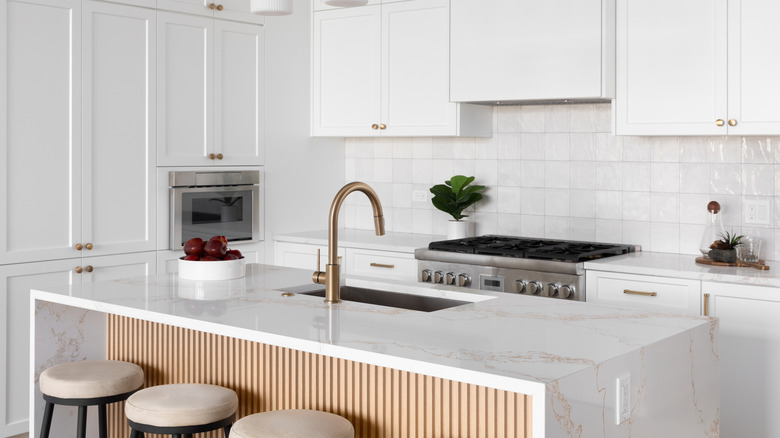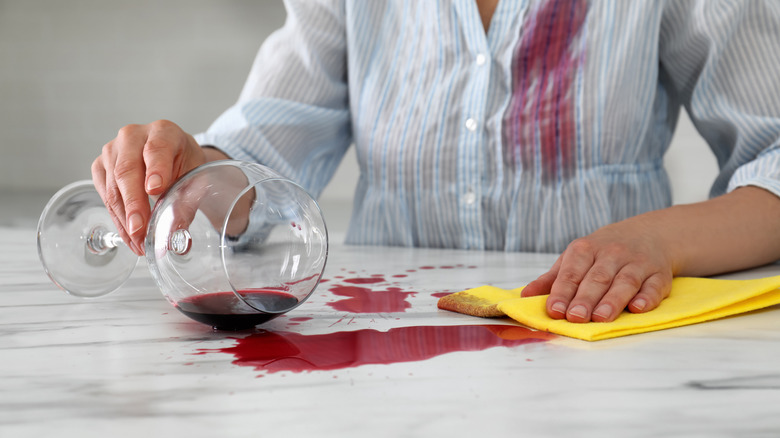Downsides To Consider Before Installing White Marble Countertops In A Luxury Kitchen
We may receive a commission on purchases made from links.
White marble was first quarried over 2,000 years ago, and has since been famously used in buildings like Rome's Pantheon and India's Taj Mahal. Michaelangelo carved a block of it to create his David, and pieces of white marble have even been found in ancient Egyptian tombs. It's a pretty impressive resume for a rock that's little more than limestone (aka calcium carbonate) exposed to lots of heat and pressure under the earth's surface.
In modern times, white marble has made its way onto kitchen countertops, becoming a stunning interior design trend that's here to stay. It's popular because it offers a timeless, classical aesthetic that screams quiet luxury and brings an airy lightness to any kitchen. It's also incredibly versatile, and plays well with materials ranging from wood to metal, fixtures ranging from chrome to rose gold, or colors ranging from teal to lavender. It's more than good-looking, though. White marble is a workhorse that's heat-resistant and durable, and tends retain its value better than other countertop materials, including granite.
Even so, white marble countertops might not always the best choice for your kitchen countertops. Marble can be finicky, prone to chipping or staining, and is not appropriate for all kitchen styles.
Cons of white marble countertops
White marble has some hidden downsides that may make you rethink using it for your countertops. Marble is a porous natural stone that needs frequent resealing to prohibit staining, and this is especially true of white marble. Think about it: Any splash of red wine or coffee, which might blend into darker colors, is very obvious against a light color. And, like any spill on a white t-shirt, if you don't get at it immediately, a hint of that stain tends to stubbornly stick around. In order to prevent staining your white marble countertops, you might need to reseal them as often as four times a year, which can be both costly and time consuming.
White marble is also prone to etching — a clouding or dulling of the finish that occurs when acids like tomato sauce or citrus come in contact with the stone's surface — that's hard to remove. While some people don't mind etching, if you don't like imperfections, it's important to understand the pros and cons of honed versus polished marble countertops. For example, polished marble has a shiny finish that shows etching a bit more. With both finishes, if etching is surface level, you can try buffing it out with some marble polishing powder and elbow grease, but if it has permeated deeper into the stone, the damage could be permanent. Calling in a professional to apply stronger-grade sealants could be your only hope.
When and where to avoid white marble countertops
While there are many classic, elegant ways to use marble in your kitchen, white marble countertops might not top that list. For instance, white marble might not fit the style of your house. HGTV's Erin Napier specifically warns against using these countertops in old homes. "It would feel really out of synchronicity to put a countertop like that in a house from 1900," she said in the "New-Stalgic Restoration" episode of "Home Town". Since kitchens used to be tucked away and purely functional, people didn't typically invest in high-end materials like white marble. It wasn't until the modern-day open floor plan made kitchens focal points of the home that incorporating luxury materials like white marble has become popular. So, if you own an older house — like a cozy vintage farmhouse or a sleek mid-century modern home — it's a good idea to consider if big slabs of white marble countertops are really the best fit with your home's age.
Finally, while white marble looks gorgeous on trendy waterfall-style countertops, it might not be the most practical choice. White marble is a softer stone that's more prone to chipping than other stones, like granite. A slab of white marble on the side of a heavily used kitchen island, for example, could be asking for trouble. The high-traffic area could translate into high potential for chipping or staining. Similarly, be cautious when using white marble on top of a kitchen island. It's beautiful on install day, but over time any staining or etching on such a large expanse of stone could make the flaw a center focus in your space.

